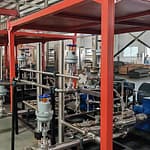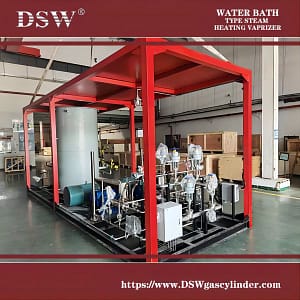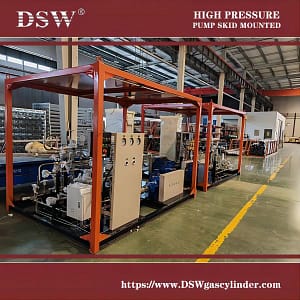Safety and Efficiency in Cryogenic Storage Tanks
Cryogenic liquid storage tanks serve the critical function of safely storing and handling cryogenic liquids. To ensure their safe operation, thoroughly considering the hazardous properties of gases, cryogenic protection mechanisms, environmental conditions, and vessel characteristics is imperative. Implementing appropriate technical management measures is essential for safe usage.
Industrial gases such as oxygen, nitrogen, argon and hydrogen are being produced in gaseous form or as cryogenic liquids. For storage or back-up cryogenic liquid tanks are used.
Example: Back-up systems
Main Components:
Tank liquid storage
Pump raises liquid pressure
Vaporiser liquid vaporised to ambient temperature

The structure and type of cryogenic liquid storage tanks. In recent years, the low-temperature liquid market has become increasingly popular. Sales of liquid oxygen, liquid argon, liquid nitrogen, liquid carbon dioxide, LNG, and natural gas have increased sharply. Non-steel products are an important part of revenue. The production, storage, and transportation of cryogenic liquids cannot be separated from cryogenic storage tanks.
Types of Cryogenic Vacuum Insulated Tanks
VIT (Vacuum Isolated Tank)
Vacuum Insulated Tank- typically for pressures up to 5 bar (g)
storage of liquid to be delivered to pump or tanker
VIE (Vacuum Isolated Evaporator)
typically for pressures up to 35 bar (g)
designed to operate with a vapouriser to supply gas to customer
suitable for supply of large quantities of product for a short time
inner vessel stainless steel, outer vessel carbon steel
insulation: vacuum interspace, perlite filled
vessels often supplied with instrumentation eg level indication, pressure protection

A special person should be responsible for the roving inspection during normal use of the cryogenic liquid storage tank. Check that the pressure of the inner container does not exceed the working pressure of the storage tank. If the pressure is exceeded, pressure relief measures should be taken. Check the status of each valve and the leakage status and find that the status is different or there is a leak.
Cryogenic Storage Tank Design
Flat Bottom Tanks
atmospheric storage held a few millibars above atmospheric pressure
large quantities of single product
inner vessel stainless steel, outer vessel carbon steel
site built tank
emergency flap valves main in/outlets
insulation: perlite interspace with a nitrogen purge
Regularly check the vacuum in the jacket of the cryogenic liquid storage tank. If the vacuum deteriorates, take additional vacuuming measures (tank storage should be invited to the professional unit or the original manufacturing unit). Find various failures of the cryogenic liquid storage tank equipment and accessories. You should always find the reason, make correct analysis and judgment, and take reasonable solutions to ensure its continuous normal operation and safe use.
Codes and Standards in Cryogenic Storage Tank Design
Internationally recognized codes and standards regulate cryogenic storage tank design, manufacturing, and operation. These guidelines ensure the safety, quality, and reliability of these specialized containers that manage substances at extremely low temperatures. Adherence to these standards is crucial to mitigate risks and prevent accidents.
Key codes and standards cover various aspects of cryogenic storage tank design, construction, and operation, including:
Table 2: Codes and Standards for Cryogenic Storage Tanks
| CODE/STANDARD | FOCUS |
|---|---|
| ASME B&PV Code Section VIII | Design principles for pressure vessels, including cryogenic tanks |
| API 620 | Design and construction of large welded low-pressure storage tanks |
| API 625 | Tank systems for refrigerated liquefied gas storage |
| NFPA 55 | Storage, use, and handling of gases in cryogenic systems |
| ISO 13458 | Cryogenic vessels – Safety devices for protection against excessive pressure |
| EN 13445 | Unfired pressure vessels, including cryogenic storage vessels |
| AISC 360 | Structural design of steel elements used in cryogenic tanks |
These codes provide comprehensive guidelines for design principles, materials, construction, safety devices, and structural considerations. Compliance with these standards ensures that cryogenic storage tanks are designed and constructed to withstand the unique challenges of extremely low temperatures and the associated hazards of cryogenic fluids.










No comment